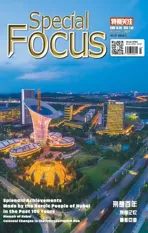Memoir of Hubei
2021-07-06
Whether in the process of finding ways to save and rejuvenate the nation,or in the course of making
the country prosperous and strong,people living and working in Hubei have committed to being pioneers since time immemorial.United together for progress,they fight against despair,strive for hope,and pursue a ray of light in the darkness whilst seeking excellence.They are heroic,great,and glorious people.
During the period of the New Democratic Revolution,Hubei was an important birthplace of the Chinese revolution,as well as various Party organizations and the People’s Liberation Army of China.Hubei has played a pivotal role in different historical stages of the Communist Party of China,from its founding to the Great Revolution,the Agrarian Revolution,the War of Resistance Against Japanese Aggression,and the War of Liberation.
Since one of the Party’s earliest organizations was established in Hubei to the complete liberation of the province,the red flags of CPC flew high throughout Hubei for 28 years.22 years of armed struggles soaked this land with the blood of the liberation fighters.700,000 people of Hubei laid down their precious lives to the Chinese revolution.235 Hubei heroes were awarded the military ranks of marshals or generals after the founding of the People’s Republic of China.As Chairman Mao said,“Those who have great ambitions are willing to sacrifice their lives,aspiring for breaking the yoke of the old society and creating a brand new world.”
从救国到兴国,从富民到强国,荆楚儿女,自古敢为人先,团结向上,为命运抗争,为希望奋斗,追求光明,追求卓越,是英勇的,是伟大的,更是光荣的。
新民主主义革命时期,湖北是中国革命的重要策源地,是中共党组织和人民军队的重要诞生地。在党的创建时期、大革命时期、土地革命时期、抗日战争时期和解放战争时期各个历史阶段,湖北均占有举足轻重的地位。
从湖北建立中国共产党早期组织到湖北全境解放,湖北28年红旗不倒,22年武装斗争相继,热血铸就了这块红色的土地,70 万荆楚儿女为中国革命献出了宝贵的生命,235 位共和国将帅从这里走出。
为有牺牲多壮志,敢叫日月换新天。

5 Representatives in the First CPC National Congress Were from Hubei
湖北为党的一大输送5 位代表
The First National Congress of the Communist Party of China,held 100 years ago,announced the formal establishment of the CPC.The Party organizations across the countr y sent 13 representatives to attend the meeting,including five representatives from Hubei:Li Hanjun,Dong Biwu,Chen Tanqiu,Liu Renjing,and Bao Huiseng.
100年前召开的中共一大,宣告中国共产党正式成立。党组织共派出13 位代表出席党的第一次全国代表大会。湖北籍代表有李汉俊、董必武、陈潭秋、刘仁静和包惠僧共5 名。

董必武Dong Biwu1886-1975湖北红安人 Hongan,Hubei
After attending the First National Congress of the Communist Party of China,Dong Biwu and Chen Tanqiu returned to Wuhan and established the CPC Wuhan Committee.After the failure of the Great Revolution (1924-1927),the leaders of the CPC East Hubei Special Committee launched the famous Huangma Uprising in the name of Dong Biwu.In October 1934,Dong hit the road with comrades in the Long March.Later,during the Chinese People’s War of Resistance Against Japanese Aggression,as a member of the delegation of the CPC Central Committee,Dong took part in the negotiations with the Kuomintang.After the founding of the People’s Republic of China,he served successively as Vice Premier,Vice President,and Acting President of the People’s Republic of China.
中共一大后,董必武和陈潭秋回到武汉,成立中共武汉地方委员会。大革命失败后,中共鄂东特委领导以董必武的名义发动著名的黄麻起义。1934年10月,董必武参加长征。抗战中,作为中共中央代表团成员之一进行国共谈判。中华人民共和国成立后历任政务院副总理、国家副主席、代主席等职。
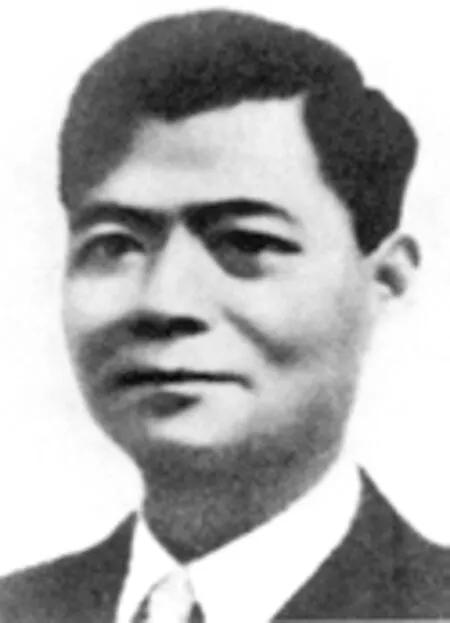
陈潭秋Chen Tanqiu1896-1943湖北黄冈人 Huanggang,Hubei
In 1922,Chen Tanqiu served as a member of the CPC Wuhan Committee,in charge of organization.In 1923,he was one of the leaders of the Beijing-Hankou Railway Strike,and later went to Anyuan,Jiangxi,to mobilize labor movements and build Party organizations.In 1924,he returned to Wuhan to serve as secretary of the CPC Wuhan Committee.He then successively served as party leader in the regions of Central China,Southeast China,North China,Northeast China,South China,and Northwest China.In 1943,he was murdered in Urumqi,Xinjiang.
1922年,任中共武汉区委委员,主管组织工作。1923年,参与领导京汉铁路大罢工,后到江西安源从事工人运动和建党工作。1924年,回到武汉任中共武汉地委书记。历任华中、东南、华北、东北、华南和西北党的负责人。1943年,牺牲于新疆乌鲁木齐。
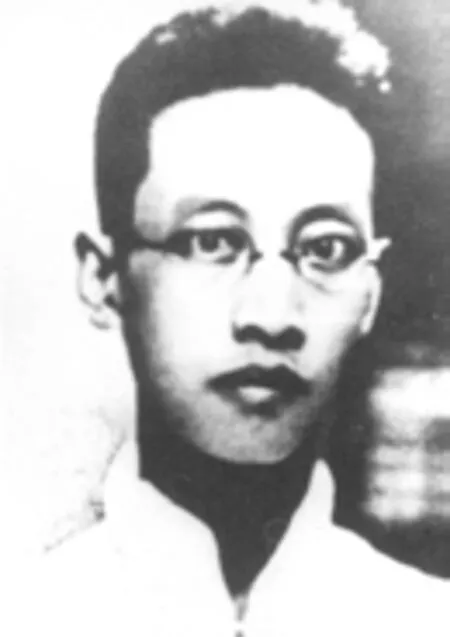
李汉俊Li Hanjun1890-1927湖北潜江人 Qianjiang,Hubei
Li Hanjun studied in Japan in his early years.Influenced by the famous Japanese Marxist and economist Hajime Kawakami,Li started to believe in Marxism.After returning to China,he actively promoted Marxism and the spirit of the October Revolution in Russia,and initiated the establishment of early Communist Party organizations in Shanghai with Chen Duxiu and many others.In 1922,Li Hanjun returned to Wuhan from Shanghai,taught at Wuchang Zhonghua University and Wuchang Higher Normal School,and was one of the leaders of the Beijing-Hankou Railway Strike.At the end of 1927,Li Hanjun was arrested by a reactionary warlord and killed on December 17th of that year.He was the first of the initial 13 representatives of the Communist Party of China to lose his life to the revolution.
早年留学日本,受日本著名马克思主义经济学家河上肇影响,信仰马克思主义。回国后积极宣传马克思主义和俄国十月革命,和陈独秀等发起成立共产党上海早期组织。1922年,从上海回到武汉,在武昌中华大学、武昌高等师范学校执教,参加领导了后来的京汉铁路大罢工。1927年底,被反动军阀逮捕,12月17日遇害,他是中共一大13 位代表中第一个为革命献身的人。

包惠僧Bao Huiseng1894-1979湖北团风人 Tuanfeng,Hubei
From 1922 to 1923,Bao Huiseng successively served as director of the Yangtze River Branch of the Secretariat of the Chinese Labor Union,member and secretary of the CPC Beijing Committee,and chairman of the CPC Wuhan Committee.Following the failure of the Great Revolution (1924-1927),he quit the CPC,astray and misguided.When the People’s Republic of China was founded,Bao Huiseng,who was in Macau at that time,made a request to return.After his return,he wrote and published a large number of memoirs about the Party during the founding period and the period of the Great Revolution (1924-1927),under the pseudonym“Old Man Qiwu,” and later publishedMemoirs of Bao Huiseng.
1922年至1923年,任中国劳动组合书记部长江支部主任、中共北京区委员会委员兼秘书、中共武汉区委员会委员长。大革命失败后,误入歧途。中华人民共和国成立后,身在澳门的包惠僧提出复归。复归后,他以“栖梧老人”为笔名,发表大量关于建党时期和大革命时期的回忆文章,后结集出版《包惠僧回忆录》。
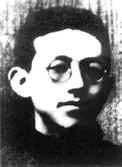
刘仁静Liu Renjing1902-1987湖北应城人 Yingcheng,Hubei
Liu Renjing was the youngest representative of the First CPC National Congress.In 1922,he foundedPioneermagazine with Deng Zhongxia.Following the founding of the People’s Republic of China,he worked as a special editor at the People’s Publishing House,engaging in translation.He later served as Counselor of the State Council,and died in Beijing on August 5,1987.
最年轻的一大代表。1922年,与邓中夏一起创办《先驱》杂志。中华人民共和国成立后,到人民出版社担任特约编辑,从事翻译工作。后任国务院参事,1987年8月5日在北京逝世。

The site of the First National Congress of the Communist Party of China中共一大旧址
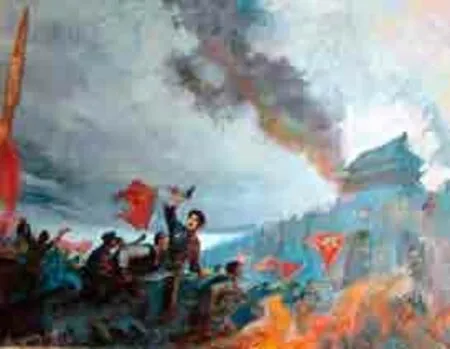
The three major forces of the Red Army were born and developed in Hubei.140,000 brave sons and daughters dedicated themselves to the revolution.They forged the Hong’an Spirit in blood.3 支红军主力部队孕育成长,14 万英雄儿女为革命献身,用鲜血凝铸成红安精神。

Cheng Ruji holding the broadsword his grandfather Cheng Zhaoxu used in the war.程儒继展示爷爷程昭续烈士用过的大刀。
The Huangma Uprising Best Interprets the Truth “The People Make the Country”
黄麻起义诠释“人民就是江山”
In September of 1927,the Communist Party Committee of Huang’an County (now Hong’an County) in Hubei Province launched the September Revolt and introduced the slogan of Agrarian Revolution to farmers and peasants for the first time,opening the prelude to the subsequent Huangma(Huang’an-Macheng) Uprising.Since then,red flags have been fluttering over this hot land.Here is where the three main forces of the Red Army were born and nurtured; and 140,000 heroic people sacrificed their lives for the revolution,using their blood to forge the Hong’an Spirit of “united as one,following the leadership of the Party,being honest,courageous and resilient,and never getting loose without seizing the final victory.”
Huang’an has a famous ballad that sings:“Never belittle the little county of Huang'an,for 480,000 people would be convening at the sound of gongs,with men to fight and women to provide.” Why is it that here “When the gongs are ringing,480,000 are convening?” Why were the people not afraid of death? Why were they persevering and unremittingly following the party? Why did the revolutionary red flags never fall here? And why did the revolutionary flames always burn amidst the bloody storm?
The answer has been proven by history:The country relies on the people,and the people make the country.
Pan Zhongru,the commander-in-chief of the uprising,Wu Guanghao,the deputy commander-in-chief,and Wu Huanxian,one of the main leaders,were all in their 20s when they sacrificed their lives.In Guanyinge Village,Qiliping Town of Hong’an County,Qin Guangyuan led 55 villagers to participate in the revolution.In the end,he was the only survivor who witnessed the birth of the People’s Republic of China and became the founding general.The 55 martyrs had an average age of 26,with the youngest being only 14 years old.
There was no regular army in the Huangma Uprising,and all the participants were peasants.At that time,about 200,000 people,men and women,old and young alike,were mobilized.Many young and middle-aged peasants enrolled in the Red Army,for which many touching scenes could be seen when the wives seeing their husbands off and mothers seeing their children off.Sometimes in just one day,more than 800 soldiers were drafted or enlisted.The people of Huang’an didn’t care about themselves.They sent their last rice to feed the Red Army,their last cloth to warm the Army,their last old cotton jackets to cover stretchers,and their last loved ones to the battlefield.“We are going to not only take over Huang’an County.We are hitting the roads,and going to take over the Dabie Mountains.We are going to take over the whole country.” These were Pan Zhongru’s sonorous last words.
1927年9月,湖北省黄安县(今红安县)委发动九月暴动,第一次向农民提出中国共产党土地革命的口号,揭开黄麻起义的序幕。从此,红旗漫卷这片热土:3 支红军主力部队孕育成长,14 万英雄儿女为革命献身,用鲜血凝铸成“万众一心、紧跟党走、朴诚勇毅、不胜不休”的红安精神。
“小小黄安,真不简单;铜锣一响,四十八万;男将打仗,女将送饭。”这就是著名的《黄安谣》。为什么这里“铜锣一响,四十八万”,人民群众不怕牺牲、百折不挠,坚定不移跟党走?为什么在腥风血雨中,这里的革命红旗始终不倒,革命火焰始终燃烧?
历史给出的答案是:江山就是人民,人民就是江山。
起义总指挥潘忠汝、副总指挥吴光浩、主要领导人之一吴焕先牺牲时,都才20 多岁。红安县七里坪镇观音阁村,秦光远带领55 位村民参加革命,最终只有他一人见证了共和国的诞生,成为开国将军。这55 名烈士,平均年龄26 岁,年纪最小的仅14 岁。
黄麻起义没有正规军队,参加者都是农民。当时动员起来的群众约20万,男的女的、老的少的,都出动了。当年,广大青壮年踊跃报名参加红军,涌现出了许多妻送夫、母送子的动人场面,一天就征兵800 余人。老百姓把最后一碗米送去做军粮,最后一尺布送去缝军装,最后一件老棉袄盖在担架上,最后一个亲骨肉送上战场。“我们不仅打下一个黄安县,我们还要打遍大别山,打遍全中国,打出我们的大路,打出我们的江山。”这是潘忠汝的铿锵遗言。
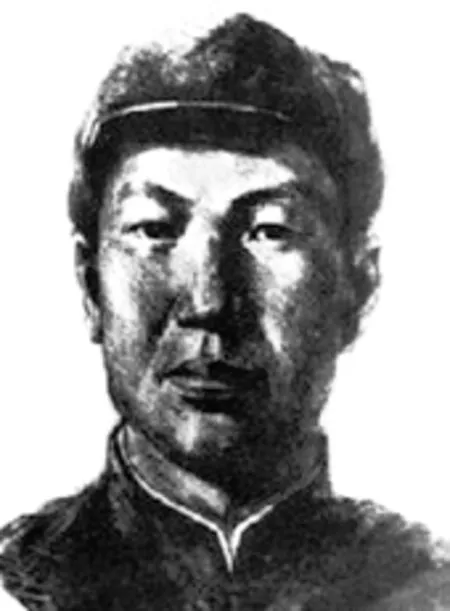
Pan Zhongru,commander-in-chief of the Huangan-Macheng Uprising,was only 21 years old when he was killed.(Profile picture)黄麻起义总指挥潘忠汝,牺牲时年仅二十一岁。(资料图片)

3,011 Red Army martyrs were buried in Etangyan Cemetery Park,among which only 29 are named,while the other 2,982 are only identified by numbers.鹅塘堰烈士墓林至今安息着3011 位红军烈士,有名字的仅29 位,2982 名无名烈士用编号代替。

This site,at No.41 Sanjiao Street,the former Russian Concession,Hankou,is where the August 7th Conference of the CPC (1927) was held.The meeting summed up the lessons of the failure of the Great Revolution (1924-1927) and set up a strategy that would launch agrarian revolutions and uprisings.From then on,Chinese society started to witness a historic shift from the Great Revolution to the Agrarian Revolution (1927-1937).八七会议旧址,汉口原俄租界三教街41 号。会议总结了大革命失败的教训,确立了实行土地革命和武装起义的方针,中国革命从此开始由大革命失败到土地革命战争兴起的历史性转变。
An Important Birthplace of the People’s Army
人民军队的重要发源地
On August 7,1927,when the Chinese revolution was facing a severe do-or-die moment,
the Communist Party of China convened an emergency conference in Hankou.There the Party summed up the lessons of the failures of the Great Revolution (1924-1927) and repositioned to a strategy of launching massive land revolutions and uprisings nationwide.After that,the Chinese Revolution embarked on its historic journey,shifting from the failed Great Revolution (1924-1927) to the launch of the Agrarian Revolution (1927-1937).
Guided by the spirit of the August 7th Conference (1927),the Party Committee of Hubei organized a series of armed uprisings.It successively set up six revolutionary bases in Hubei and its surrounding areas,including the Hubei-Henan-Anhui Base,Hunan-Western Hubei Base,and Hunan-Hubei-Jiangxi Base,and more importantly,established major people’s revolutionary armed forces,such as the Fourth Front Army,the Second and Third Corps,and the Twenty-Fifth Army of the Red Army,which then accounted for about half of the country’s forces in the Red Army and laid a solid foundation for the Agrarian Revolution.
From October of 1934 to October of 1936,the First,Second,and Fourth Front Armies of the Red Army and the 25th Army of the Red Army,under the leadership of the Communist Party of China,successively carried out a strategic shift—marching from the revolutionary bases in the north and south of the Yangtze River to the Shaanxi-Gansu region in North China.The Long March,as it became known,stunned the world.
In October of 1937,the Kuomintang and the CPC reached an agreement to reorganize the Red Army and guerrillas in the 8 provinces and 14 regions of south China into the New Fourth Army of the National Revolutionary Army (referred to as the New Fourth Army),and Ye Ting established the first headquarters in Wuhan for the New Army.
1927年8月7日,在中国革命处于严重危机的时刻,中国共产党在汉口召开紧急会议,总结了大革命失败的教训,确立了实行土地革命和武装起义的方针。中国革命从此开始由大革命失败到土地革命兴起的历史性转变。
在八七会议精神的指引下,湖北地区党相继组织发动了一系列武装起义,在湖北及周边地区开辟了鄂豫皖、湘鄂西、湘鄂赣等6 大革命根据地,组建了红四方面军、红二军团、红三军团和红二十五军等主力红军,创建了占全国主力红军二分之一左右的人民革命武装,为土地革命奠定了重要基础。
1934年10月至1936年10月,中国共产党领导的中国工农红军第一、第二、第四方面军和第二十五军陆续从长江南北各革命根据地向陕甘地区进行战略大转移,这就是震惊世界的两万五千里长征。
1937年10月,国共两党达成协议,将南方8 省14 地区的红军、游击队改编为国民革命军陆军新编第四军(简称新四军),叶挺在武汉组建新四军首个军部。

Teng Daiyuan,secretary of the Special Committee of the Communist Party of China for Hunan-Hubei-Jiangxi Border Area.In the spring of 1928,the Special Committee of CPC Hunan-Hubei-Jiangxi Border Area was set up,and the Fifth Army of the Chinese Workers’and Peasants’ Red Army was established.1928年春,中共湘鄂赣边特委成立,建立了中国工农红军第五军。图为中共湘鄂赣边特委书记滕代远。
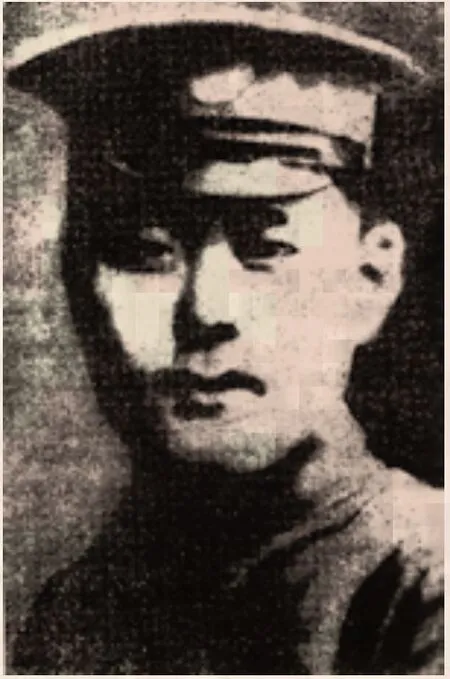
Xu Jishen,commander of the First Red Army.Between March and April of 1930,the Special Committee of CPC Hubei-Henan-Anhui Border Areas was set up to collectively manage the Party organizations in the three revolutionary bases of the Hubei-Henan Border Area,Southeast Henan Area,and West Anhui Area,and the First Red Army was established.1930年3-4月,统一管辖鄂豫边、豫东南、皖西三块根据地党组织的中共鄂豫皖边特委和红一军先后成立。图为红一军军长许继慎。
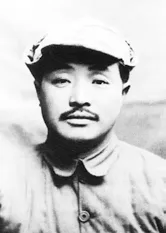
He Long,commander-in-chief of the Second Corps of the Red Army.On July 4,1930,the Fourth Red Army and the Sixth Red Army successfully joined forces in Gong’an County,Hubei,to form the Second Corps of the Red Army.1930年7月4日,红四军和红六军在公安县胜利会师,成立红二军团。图为红二军团总指挥贺龙。

Xu Xiangqian,commanderin-chief of the Fourth Front Army of the CPC established in Qiliping,Huang’an County(Now Hong’an County),Hubei in November of 1931.1931年11月,中国工农红军第四方面军在七里坪成立。图为总指挥徐向前。
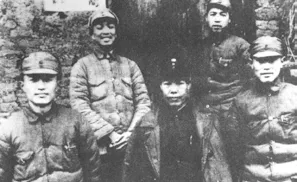
Party and military leaders in charge of the border region in Jingshan County,Hubei Province:Zhu Lizhi (left),Chen Shaomin (middle),and Li Xiannian (right) in the front row,and Zheng Shaowen (left)and Liu Shaoqing (right) in the back row.In January 1940,the New Fourth Army’s Henan-Hubei Advance Brigade was established,with Li Xiannian serving as the commander and Zhu Lizhi as the political commissar.1940年1月,新四军豫鄂挺进纵队成立,李先念任司令员,朱理治任政治委员。图为边区党和军队主要负责人在京山合影。前排左起:朱理治、陈少敏、李先念,后排左起:郑绍文、刘少卿。
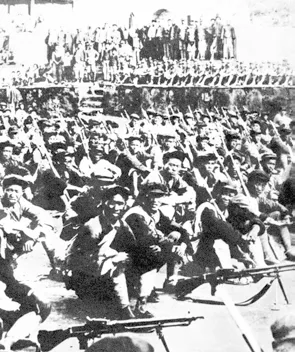
The Twenty-Fifth Army of the Red Army,which arrived in northern Shaanxi after the Long March from the Hubei-Henan-Anhui Border Area,joins forces with the Twentysixth and Twenty-seventh Armies in Yongping Town,North Shaanxi to form the Fifteenth Corps of the Red Army on September 5,1935.1935年9月5日,由鄂豫皖长征到达陕北的红二十五军与陕北红二十六、二十七军在陕北永平镇会师,成立红十五军团。图为会师时的情景。

Deng Xiaoping giving a report titled “The Current Situation and Advancing to Dabie Mountains” at the Cadre Conference held at the Dabie Mountains.邓小平在大别山召开的干部大会上作《目前的形势和挺进大别山》的报告。

CPC troops breaking through the Kuomintang army’s blockade in the Central Plains Breakthrough Campaign.中原突围部队突破国民党部队封锁钱。
“The Central Plains Breakthrough”—Starting point of the National War of Liberation
“中原突围”全国解放战争的起点
After the victory of the Chinese People’s War of Resistance Against Japanese Aggression,
China entered a period of decisive battle with two destinies and two futures at stake.The Liberated Areas of the Central Plains,centered in Hubei,was the top choice for the Kuomintang army to launch a war against the CPC due to its strategic position.On June 26,1946,the Kuomintang brazenly scrapped the “Armistice Agreement” and laid a large-scale siege on the troops of the CPC Central Plains Military Region,openly provoking a full-scale civil war.In accordance with the instructions of the Central Committee of the Communist Party of China,the troops of the Central Plains Military Region launched the Central Plains Breakthrough Campaign.This event opened the prelude to the National Liberation War and became a milestone for the CPC to move from guerrilla bases to the whole country.
Within a year of the Central Plains Breakthrough Campaign,major changes had taken place in the landscape of the war.The Central Committee of the Communist Party of China made the strategic decision that ordered the army led by Liu Bocheng and Deng Xiaoping to march a thousand miles to the Dabie Mountains.In June of 1947,Liu and Deng’s army marched to the Dabie Mountains and set up a new liberated area in the Central Plains,which was home to a population of 30 million.This marked a great shift for the CPC,from strategic defense to strategic offensive over the 20 years of the people’s revolutionary war,as Chairman Mao Zedong commented:“Once this shift occurs,our national victory will inevitably occur.”
The Fifth Division of the New Fourth Army and the Central Plains Military Region continued to grow and develop.They established and expanded many liberated areas,such as the Hubei-Henan Liberated Area,Yangtze-Hanshui Liberated Area,Tongbai Liberated Area,and the Southern Shaanxi Liberated Area,one after another.The Central Plains region,which had an extremely important strategic position,was now a strategic outpost for the Chinese Communist Party’s northward expansion and southward defense system.
抗日战争胜利后,中国进入到两种命运、两种前途的决战时期,以湖北为中心的中原解放区,因其特殊的战略地位而成为国民党军发动内战的首选目标。1946年6月26日,国民党军悍然撕毁“停战协定”,向中原军区部队发动大举围攻,公然挑起大规模全面内战。中原军区部队根据中共中央指示,发起了震惊中外的中原突围战役,揭开了全国解放战争的序幕,成为党从根据地走向全国的一座里程碑。
中原突围一年后,全国战局发生了重大变化,中共中央作出了刘邓大军千里跃进大别山的战略决策。1947年6月,刘邓大军千里跃进大别山,开辟了拥有3000 万人口的新的中原解放区,胜利实现了人民革命战争20年来由战略防御向战略进攻的转变。毛泽东评价说:“这个事变一经发生,它就将必然地走向全国的胜利。”
新四军第五师和中原军区部队不断发展壮大,鄂豫、江汉、桐柏、陕南等解放区相继建立和发展。战略地位极其重要的中原地区成为中国共产党向北发展、向南防御体系的战略前哨。

The major forces of the Army,led by Liu Bocheng and Deng Xiaoping,marching southward and down to the Yangtze River to evade the enemy’s siege.为摆脱敌军合击,刘邓大军主力长驱直下,逼近长江。
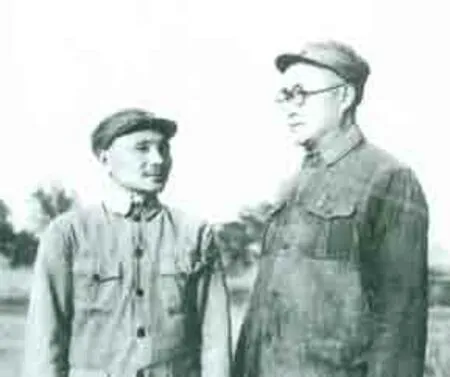
Liu Bocheng (right) and Deng Xiaoping on the military campaign to South China南征途中的刘伯承(右)和邓小平

Mao Zedong (third from right in the front row)with the cadres of the 359th Brigade who arrived in Yan’an after achieving victory in the Central Plains Breakthrough Campaign.毛泽东(前排右三)同中原突围后到达延安的第三五九旅干部合影。

People from all walks of life in Wuhan celebrate the liberation of Wuhan and Shanghai on June 4,1949.1949年6月4日,武汉市各界庆祝武汉上海解放大会。
